Obtaining Cross-Sections of Paint Layers in Cultural Artifacts Using Femtosecond Pulsed Lasers
Abstract
:1. Introduction
2. Sample Description and Experimental Setup
3. Results and Discussion
3.1. Comparison of Scalpel, CW Laser, and Femtosecond Pulsed Laser
3.2. Comparison of the Effects of CW and Femtosecond Pulsed Lasers on a Variety of Paint Samples
3.3. Effects of Average Power and Cutting Speed
4. Conclusions
Author Contributions
Conflicts of Interest
Appendix A
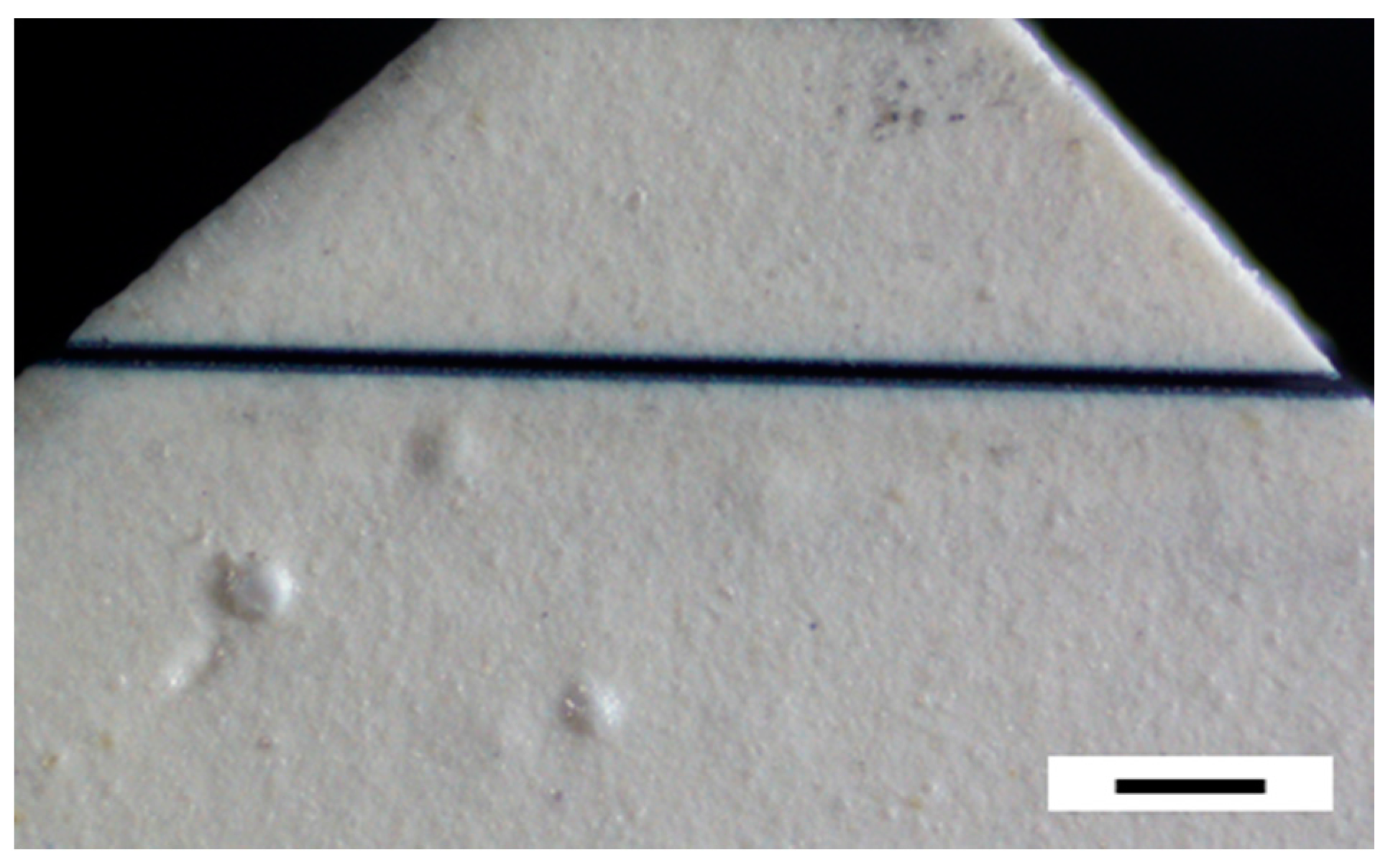
References
- Gattass, R.R.; Mazur, E. Femtosecond Laser Micromachining in Transparent Materials. Nat. Photonics 2008, 2, 219–225. [Google Scholar] [CrossRef]
- Keller, U. Recent Developments in Compact Ultrafast Lasers. Nature 2003, 424, 831–838. [Google Scholar] [CrossRef] [PubMed]
- Meunier, M.; Fisette, B.; Houle, A.; Kabashin, A.V.; Broude, S.V.; Miller, P. Processing of Metals and Semiconductors by a Femtosecond Laser-Based Microfabrication System. In Proceedings of the SPIE, Commercial and Biomedical Applications of Ultrafast Lasers III, San Jose, CA, USA, 25 January 2003.
- Perry, M.D.; Stuart, B.C.; Banks, P.S.; Feit, M.D.; Yanovsky, V.; Rubenchik, A.M. Ultrashort-Pulse Laser Machining of Dielectric Materials. J. Appl. Phys. 1999, 85, 6803–6810. [Google Scholar] [CrossRef]
- Vorobyev, A.Y.; Guo, C. Direct Creation of Black Silicon using Femtosecond Laser Pulses. Appl. Surf. Sci. 2011, 257, 7291–7294. [Google Scholar] [CrossRef]
- Madéo, J.; Margiolakis, A.; Zhao, Z.-Y.; Hale, P.J.; Man, M.K.L.; Zhao, Q.-Z.; Peng, W.; Shi, W.-Z.; Dani, K.M. Ultrafast Properties of Femtosecond-Laser-Ablated GaAs and its Application to Terahertz Optoelectronics. Opt. Lett. 2015, 40, 3388–3391. [Google Scholar]
- Klein, S.; Fekrsanati, F.; Hildenhagen, J.; Dickmann, K.; Uphoff, H.; Marakis, Y.; Zafiropulos, V. Discoloration of Marble during Laser Cleaning by Nd:YAG Laser Wavelengths. Appl. Surf. Sci. 2001, 171, 242–251. [Google Scholar] [CrossRef]
- Siano, S.; Agresti, J.; Cacciari, I.; Ciofini, D.; Mascalchi, M.; Osticioli, I.; Mencaglia, A.A. Laser Cleaning in Conservation of Stone, Metal, and Painted Artifacts: State of the Art and New Insights on the Use of the Nd:Yag Lasers. Appl. Phys. A 2012, 106, 419–446. [Google Scholar] [CrossRef]
- Andreotti, A.; Brown, W.P.; Camaiti, M.; Colombini, M.P.; DeCruz, A. Diagnosis of Materials and Effectiveness of Er:YAG Laser Cleaning as Complementary Treatment in A Panel Painting Attributed to Lluís Borrassà (Fifteenth Century). Appl. Phys. A 2016, 122, 572. [Google Scholar] [CrossRef]
- DeCruz, A.; Wolbarsht, M.L.; Andreotti, A.; Colombini, M.P.; Pinna, D.; Culberson, C.F. Investigation of the Er:YAG Laser at 2.94 μm to Remove Lichens Growing on Stone. Stud. Conserv. 2009, 54, 268–277. [Google Scholar] [CrossRef]
- Teule, R.; Scholten, H.; van den Brink, O.F.; Heeren, R.M.A.; Zafiropulos, V.; Hesterman, R.; Castillejo, M.; Martín, M.; Ullenius, U.; Larsson, I.; et al. Controlled UV Laser Cleaning of Painted Artworks: A Systematic Effect Study on Egg Tempera Paint Samples. J. Cult. Herit. 2003, 4, 209–215. [Google Scholar] [CrossRef]
- Oujja, M.; Garcia, A.; Romero, C.; Vazquez de Aldana, J.R.; Moreno, P.; Castillejo, M. UV Laser Removal of Varnish on Tempera Paints with Nanosecond and Femtosecond Pulses. Phys. Chem. Chem. Phys. 2011, 13, 4625–4631. [Google Scholar] [CrossRef] [PubMed]
- Villafana, T.E.; Brown, W.P.; Delaney, J.K.; Palmer, M.; Warren, W.S.; Fischer, M.C. Femtosecond Pump-Probe Microscopy Generates Virtual Cross-Sections in Historic Artwork. Proc. Natl. Acad. Sci. USA 2014, 111, 1708–1713. [Google Scholar] [CrossRef] [PubMed]
- Ghany, K.A.; Newishy, M. Cutting of 1.2 mm Thick Austenitic Stainless Steel Sheet Using Pulsed and CW Nd:YAG Laser. J. Mater. Process. Tech. 2005, 168, 438–447. [Google Scholar] [CrossRef]
- Moody, J.E.; Hendel, R.H. Temperature Profiles Induced by a Scanning CW Laser Beam. J. Appl. Phys. 1982, 53, 4364–4371. [Google Scholar] [CrossRef]
- Schvan, P.; Thomas, R.E. Time-Dependent Heat Flow Calculation of CW Laser-Induced Melting of Silicon. J. Appl. Phys. 1985, 57, 4738–4741. [Google Scholar] [CrossRef]
- Chichkov, B.N.; Momma, C.; Nolte, S.; von Alvensleben, F.; Tünnermann, A. Femtosecond, Picosecond and Nanosecond Laser Ablation of Solids. Appl. Phys. A 1996, 63, 109–115. [Google Scholar] [CrossRef]
- Derrick, M.; Souza, L.; Kieslich, T.; Florsheim, H.; Stulik, D. Embedding Paint Cross-Section Samples in Polyester Resins: Problems and Solutions. J. Am. Inst. Conserv. 1994, 33, 227–245. [Google Scholar] [CrossRef]
- Kaszewska, E.A.; Sylwestrzak, M.; Marczak, J.; Skrzeczanowski, W.; Iwanicka, M.; Szmit-Naud, E.; Anglos, D.; Targowski, P. Depth-Resolved Multilayer Pigment Identification in Paintings: Combined Use of Laser-Induced Breakdown Spectroscopy (LIBS) and Optical Coherence Tomography (OCT). Appl. Spectrosc. 2013, 67, 960–972. [Google Scholar] [CrossRef] [PubMed]
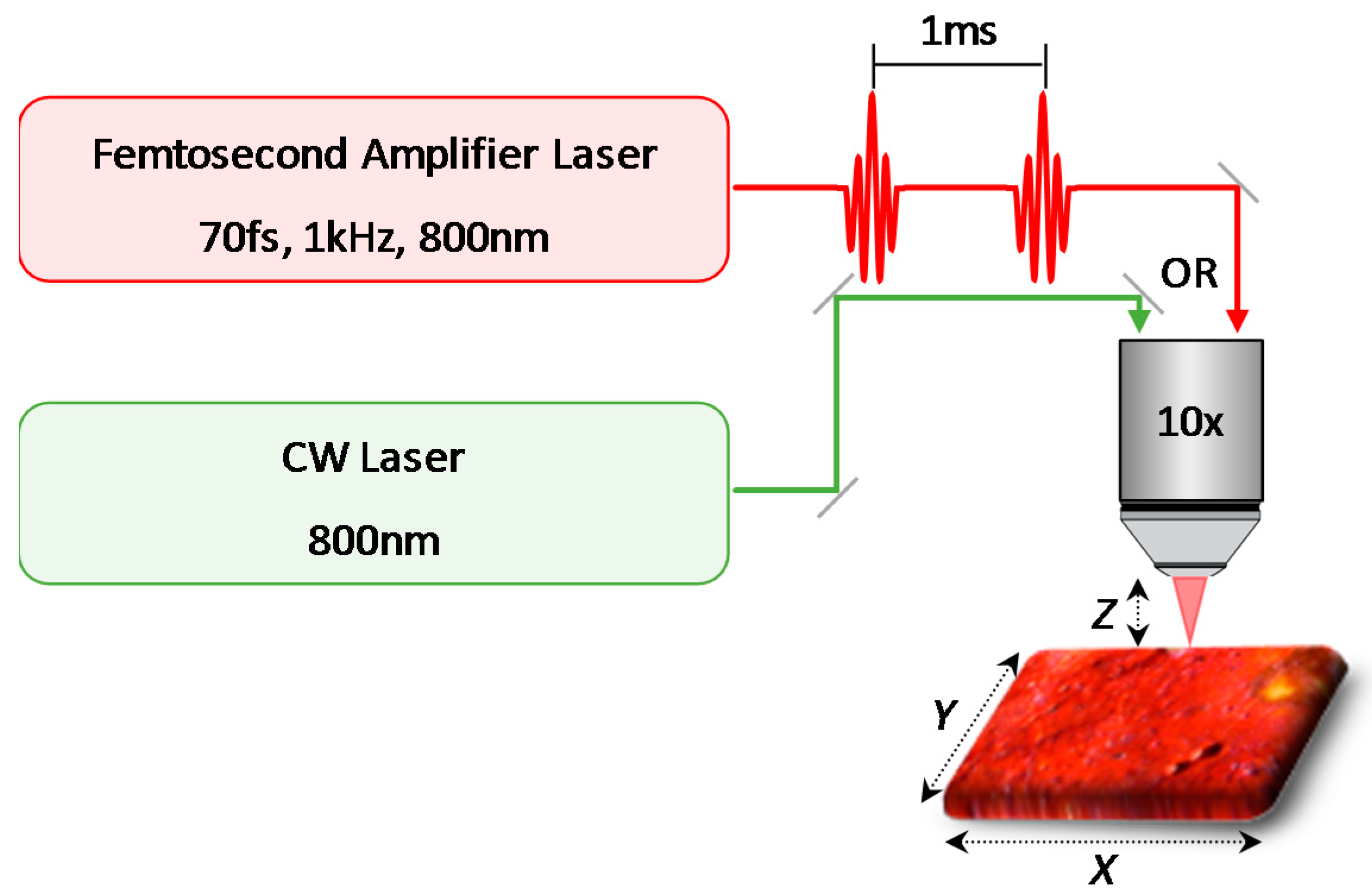
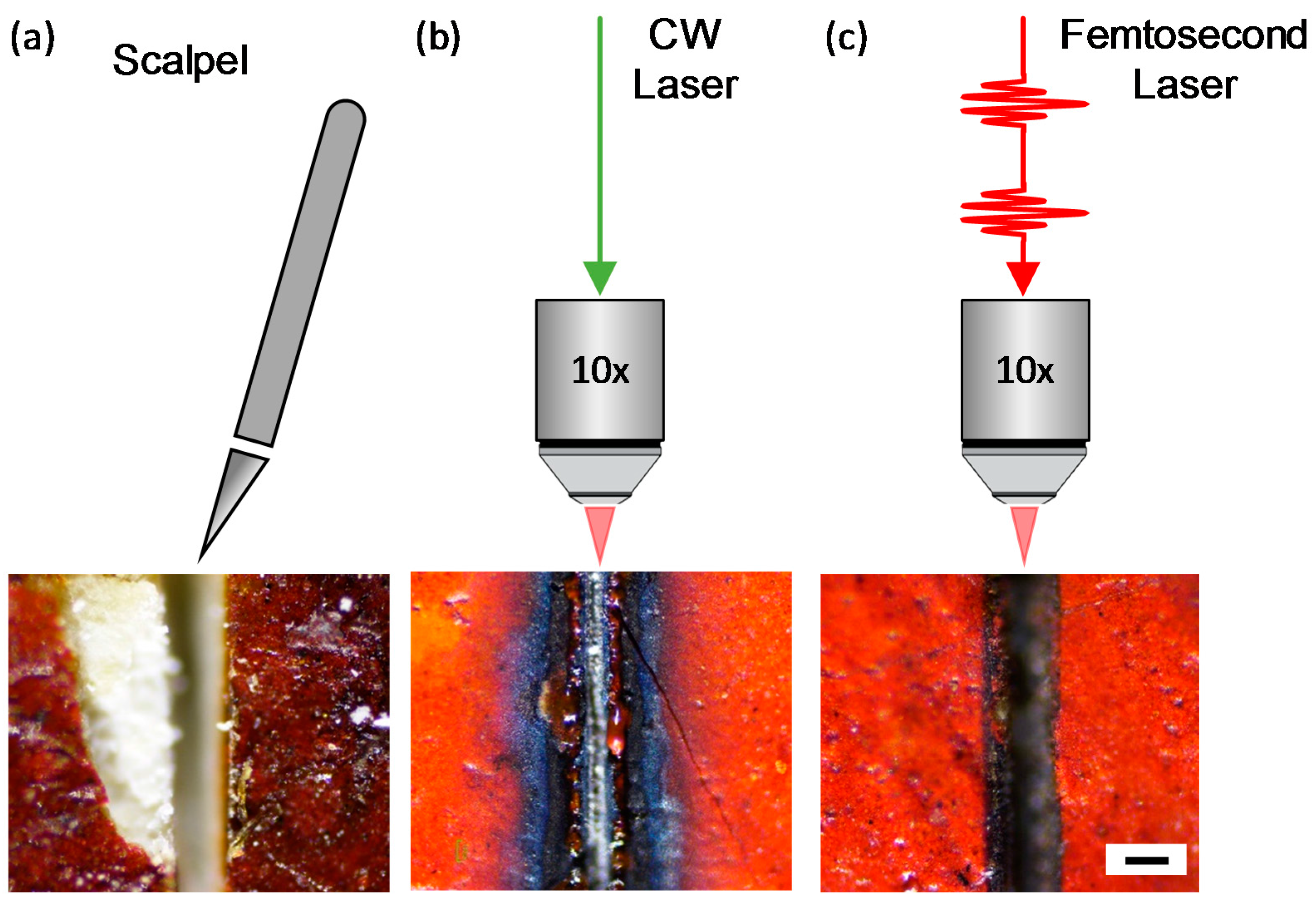
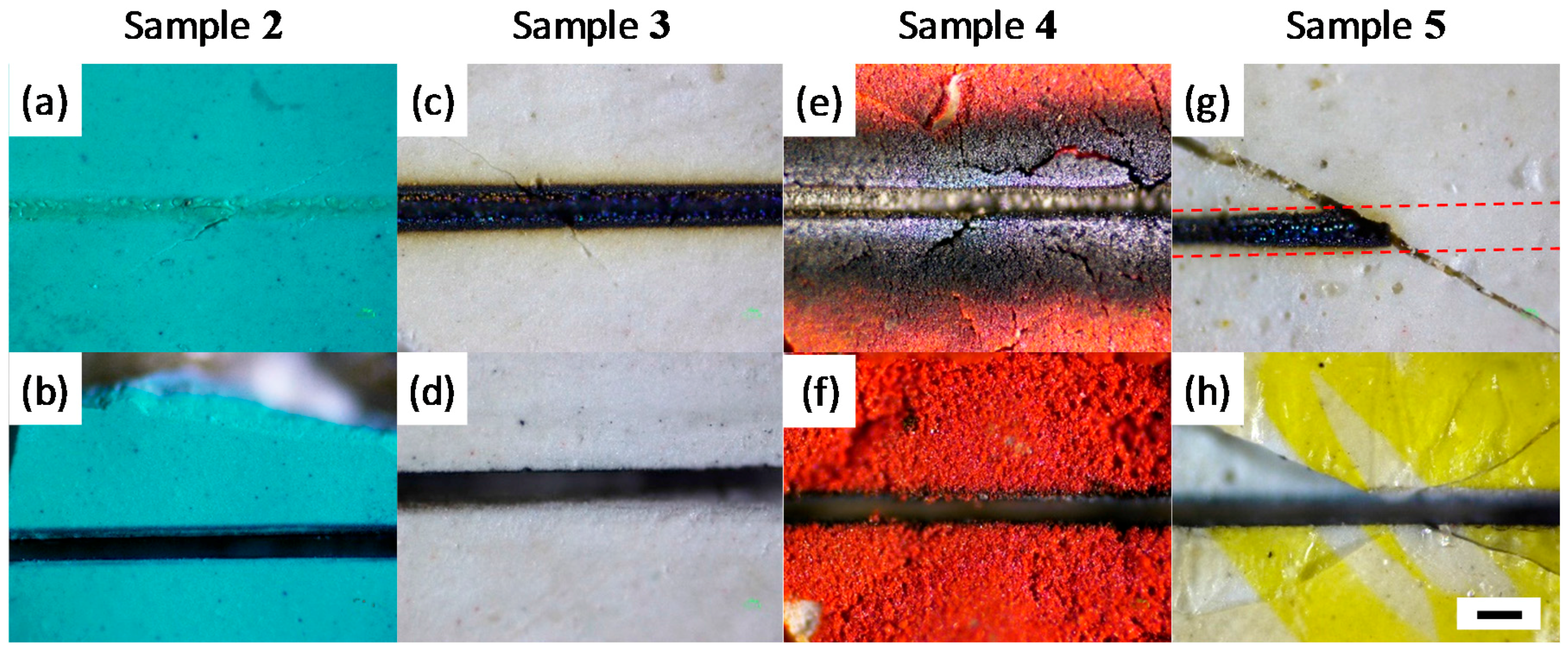

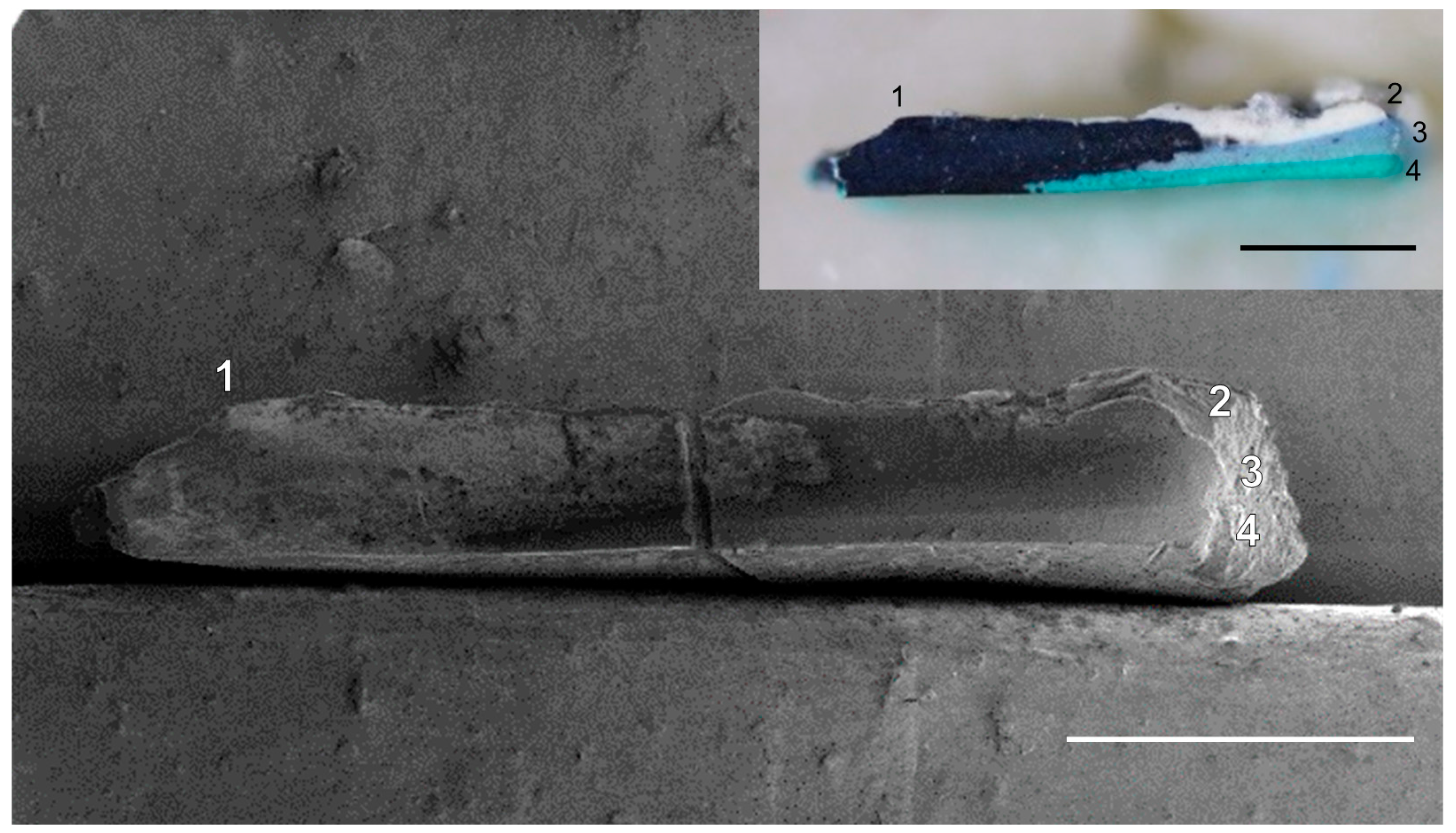
| Paint | Color | Year | Paint Thickness (μm) | Total Thickness (μm) | Varnish |
|---|---|---|---|---|---|
| Sample 1 | Red/Brown 1 | 19th Century | - | 200 | Top |
| Sample 2 | Turquoise | 1977 | 250 | 740 | - |
| Sample 3 | While | 1980s | 220 | 590 | Underneath |
| Sample 4 | Red | 1980s | 120 | 490 | - |
| Sample 5 | Yellow-White 1 | 1980s | 100 | 470 | Top |
© 2017 by the authors. Licensee MDPI, Basel, Switzerland. This article is an open access article distributed under the terms and conditions of the Creative Commons Attribution (CC BY) license ( http://creativecommons.org/licenses/by/4.0/).
Share and Cite
Harada, T.; Spence, S.; Margiolakis, A.; Deckoff-Jones, S.; Ploeger, R.; Shugar, A.N.; Hamm, J.F.; Dani, K.M.; Dani, A.R. Obtaining Cross-Sections of Paint Layers in Cultural Artifacts Using Femtosecond Pulsed Lasers. Materials 2017, 10, 107. https://doi.org/10.3390/ma10020107
Harada T, Spence S, Margiolakis A, Deckoff-Jones S, Ploeger R, Shugar AN, Hamm JF, Dani KM, Dani AR. Obtaining Cross-Sections of Paint Layers in Cultural Artifacts Using Femtosecond Pulsed Lasers. Materials. 2017; 10(2):107. https://doi.org/10.3390/ma10020107
Chicago/Turabian StyleHarada, Takaaki, Stephanie Spence, Athanasios Margiolakis, Skylar Deckoff-Jones, Rebecca Ploeger, Aaron N. Shugar, James F. Hamm, Keshav M. Dani, and Anya R. Dani. 2017. "Obtaining Cross-Sections of Paint Layers in Cultural Artifacts Using Femtosecond Pulsed Lasers" Materials 10, no. 2: 107. https://doi.org/10.3390/ma10020107
APA StyleHarada, T., Spence, S., Margiolakis, A., Deckoff-Jones, S., Ploeger, R., Shugar, A. N., Hamm, J. F., Dani, K. M., & Dani, A. R. (2017). Obtaining Cross-Sections of Paint Layers in Cultural Artifacts Using Femtosecond Pulsed Lasers. Materials, 10(2), 107. https://doi.org/10.3390/ma10020107





